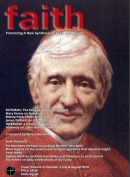Cutting Edge
FAITH Magazine March - April 2008
A Special feature keeping us up to date with issues of science and religion
DAVIES, POPPER AND THE UNITY-LAW ‘MIDDLE WAY’
It was in the famous ‘op-ed’ column of the New York Timesin July 2005 that Cardinal Schönborn opened up a fascinating and vigorous debate about faith and science. Last November another major contributor at the faith–science interface, English cosmologist Paul Davies, graced the ‘oped’ page of the same newspaper with a provocative piece entitled Taking Science on Faith(24th November 2007).
The article is about challenging assumptions, and setting out to prove that much of the way science currently proceeds is also to take certain things ‘on faith’. He explains how the orthodox view amongst theoretical physicists is that there is, ‘out there,’ a perfect, unified law – it is the very goal of the sort of ‘grand unified theory’ that many physicists are aiming at. And this is, he suggests, just as much a sort of ‘faith’ as the Christian view of a creator God. “Over the years I have often asked my physicist colleagues why the laws of physics are what they are. The answers vary from ‘that's not a scientific question’ to ‘nobody knows’. The favourite reply is, ‘There is no reason they are what they are – they just are’. The idea that the laws exist reasonlessly is deeplyanti-rational. ...Can the mighty edifice of physical order we perceive in the world about us ultimately be rooted in reasonless absurdity?” Recent attempts to explain away the fine-tuning of the universe’s laws by hypothesising a ‘multiverse’ of different universes do not convince Davies: “The multiverse theory is increasingly popular, but it doesn’t so much explain the laws of physics as dodge the whole issue. ...The problem has simply been shifted up a level from the laws of the universe to the meta-laws of the multiverse”.
He suggests that “the very notion of a physical law is a theological one in the first place, a fact that makes many scientists squirm. Isaac Newton first got the idea of absolute, universal, perfect, immutable laws from the Christian doctrine that God created the world and ordered it in a rational way”. Now, in fact, Davies’s intention, made clear in his response to critics of the article, is to challenge this orthodoxy concerning an immutable law which is just a ‘given’. He, somewhat fancifully, proposes that it is conceivable that the laws of the universe need not necessarily be immutable, or defined ‘from outside’ the universe, and he is looking to investigate this possibility. But, he says, if instead physics is going to adhere to the idea of a perfect physical law, then“[science’s] claim to be free of faith is manifestly bogus”.
He explains more precisely what he means in his response to the critics: “in using the word faith I refer to the metaphysical framework, sharedby monotheism and science (but not by many other cultures), of a rational ground that underpins physical existence. It is the shared faith that we live in a universe that is coherent, a universe that manifests a specific mathematical scheme of things, a universe that is, at least in part, intelligible to sentient mortals. These tacit assumptions running through science, that stem from monotheism, can all be challenged. The universe doesn’t haveto be that way! But most scientists believe it isthat way”. Davies thus proposes a “shared failing” of reason plugged by an a priori faith in both religion and science.
He has come under attack from his fellow scientists for his article. They tend to argue that the scientific intuition that things will happen in the future somewhat as they always have, is mainly based on the fact that this has worked well in the past four centuries, and so is not the quasi-religious faith Davies suggests. They therefore see science as founded on a rational belief concerning a probable future. But Davies, rightly in our opinion, discerns a much stronger knowledge claim amongst scientists concerning a definite future. He points to scientists’ certainty about the “immutable” nature of laws across the past and future. Such conviction is in contrast with the widely accepted Popperian ‘rational’ affirmation of the inherent provisionality of scientific theory.
Davies cites the popular search for a unified field theory and he asks, whence such conviction about such a truly universal state of affairs? From monotheistic faith he replies, and depicts his detractors’ pieces as bearing “the hallmarks of a superficial knee-jerk reaction”.
Something more than past patterns is indeed surely needed to justify the scientific certainty concerning predictability. But Davies is surely wrong to jump to the conclusion that this something more is an a priori quasireligious faith. Perhaps the truth lies between these two poles.
All physical reality is intrinsically and constructively orientated beyond itself. An aspect of this is the past’s developmental orientation towards the future. It is this rational recognition, in all our observation of the cosmos, which is at the heart of the predictive success of science. This universal human recognition is not immediately comparable to religious faith, but nor is it simply a conviction that past patterns will be repeated in the future because they usuallly have done before.
Davies’ detractors are right that scientific affirmations about the future, and indeed expectations concerning a unified field theory, are founded in rational observation. Davies is right that the strength of conviction behind these affirmations goes beyond the fashionable, Popperian, philosophy of science which deals in the currency of the purely provisional and fails explicitly to found its expectations. They are each wrong in ignoring the unity forming and constructive relationality which human rationality discovers at the heart of everything.
As touched on in our current editorial the transcendent orientation towards higher unities of all physical things is mirrored in the artefacts of man, which are, in as much as these things are ‘real’ things, directly relative to the spiritual minds of men. This intrinsic, purposeful relationality written into matter as it is, can only come from ultimate Mind.
The critical responses to Davies’s article, and his counter-response, are at:
https://www.edge.org/discourse/science\_faith.html






